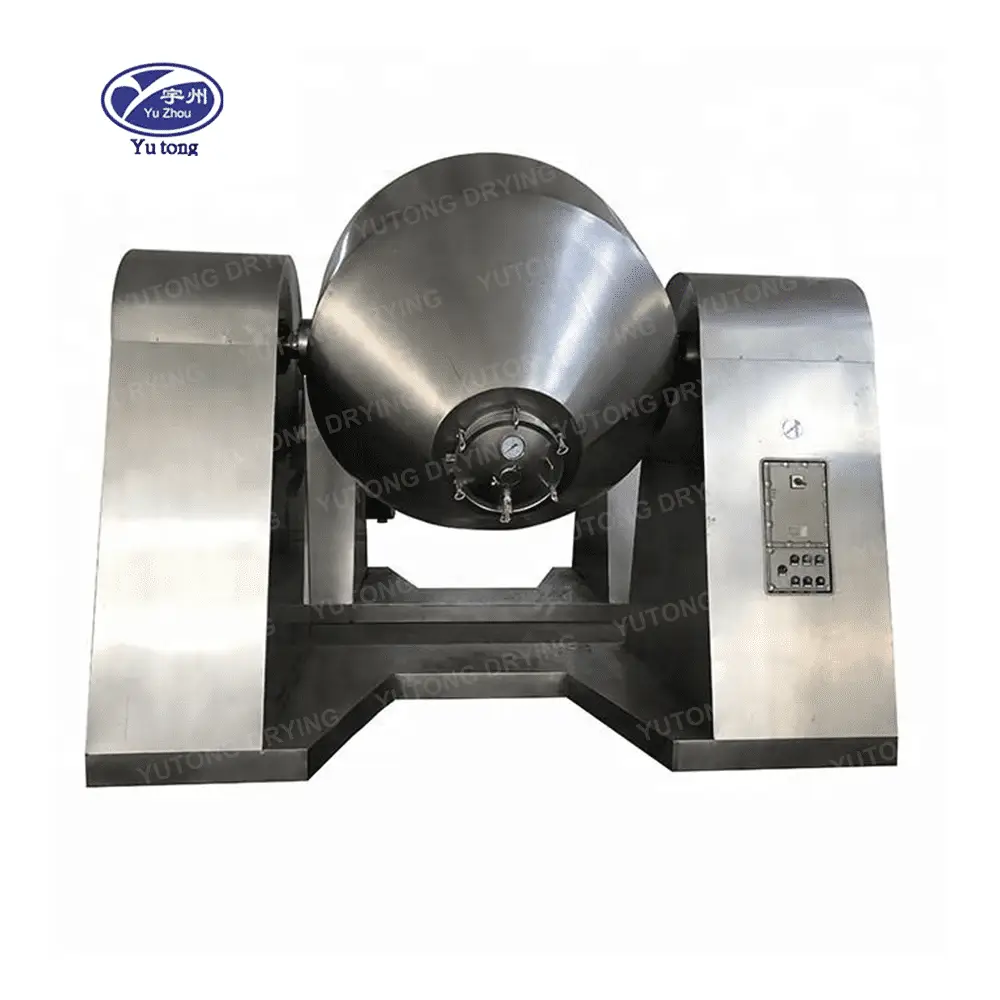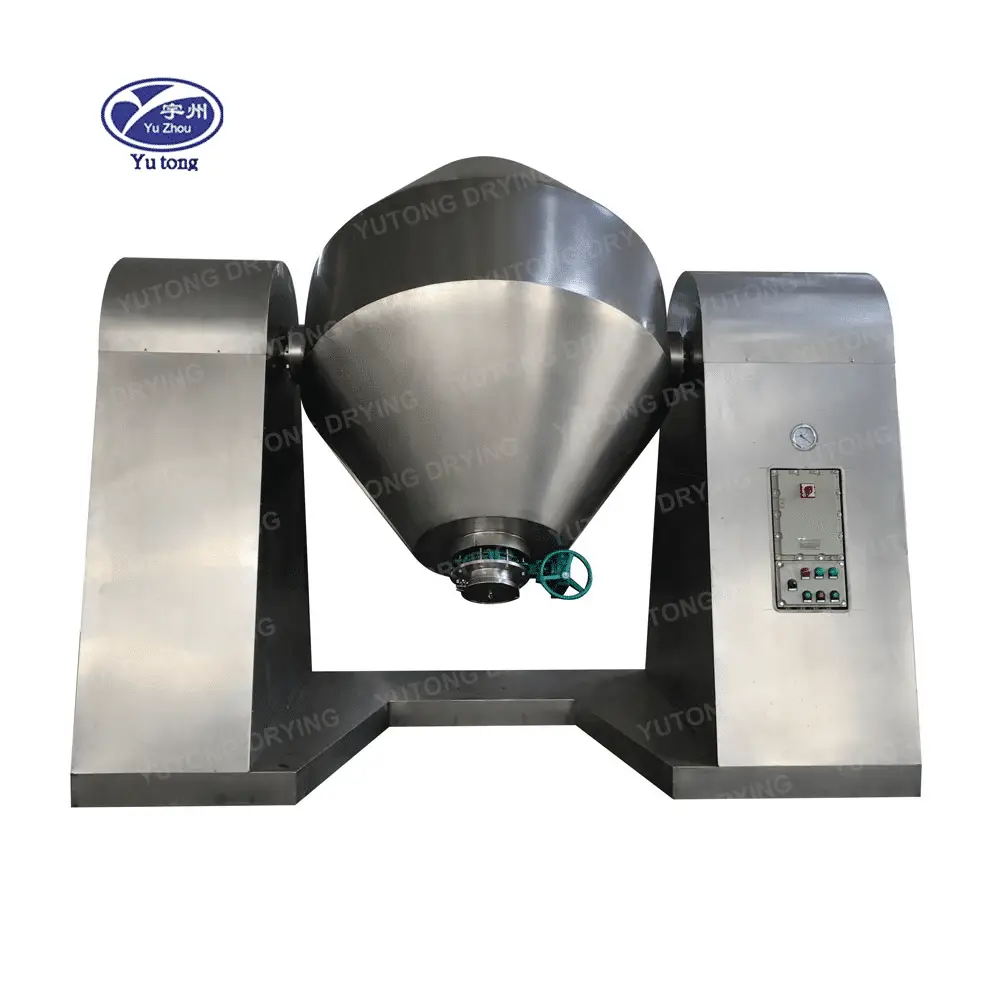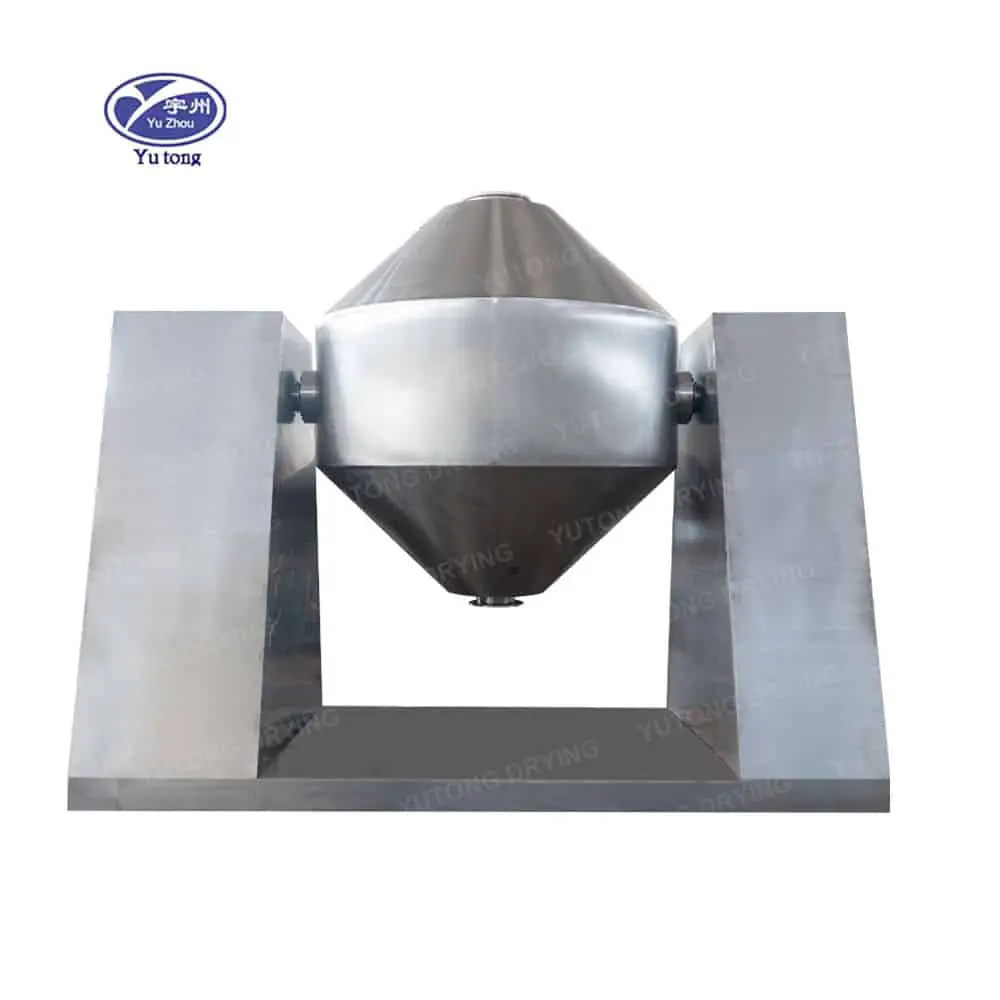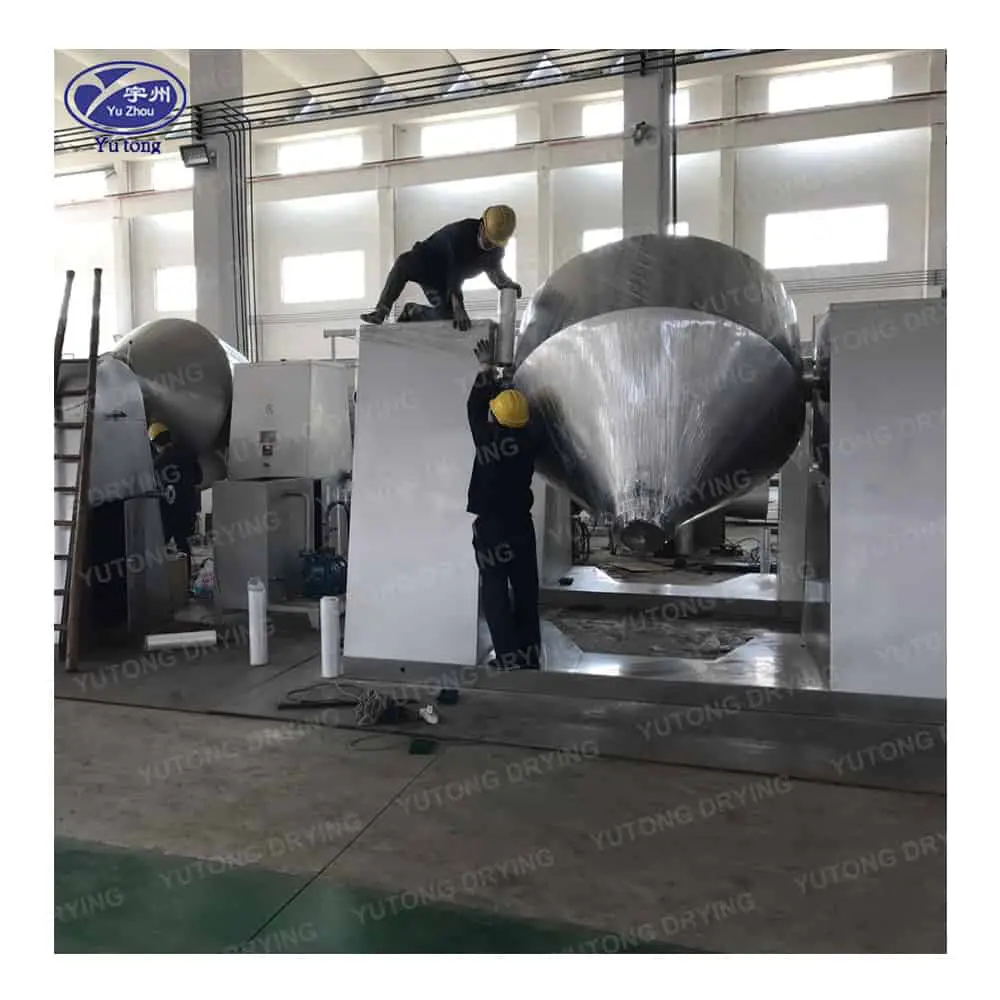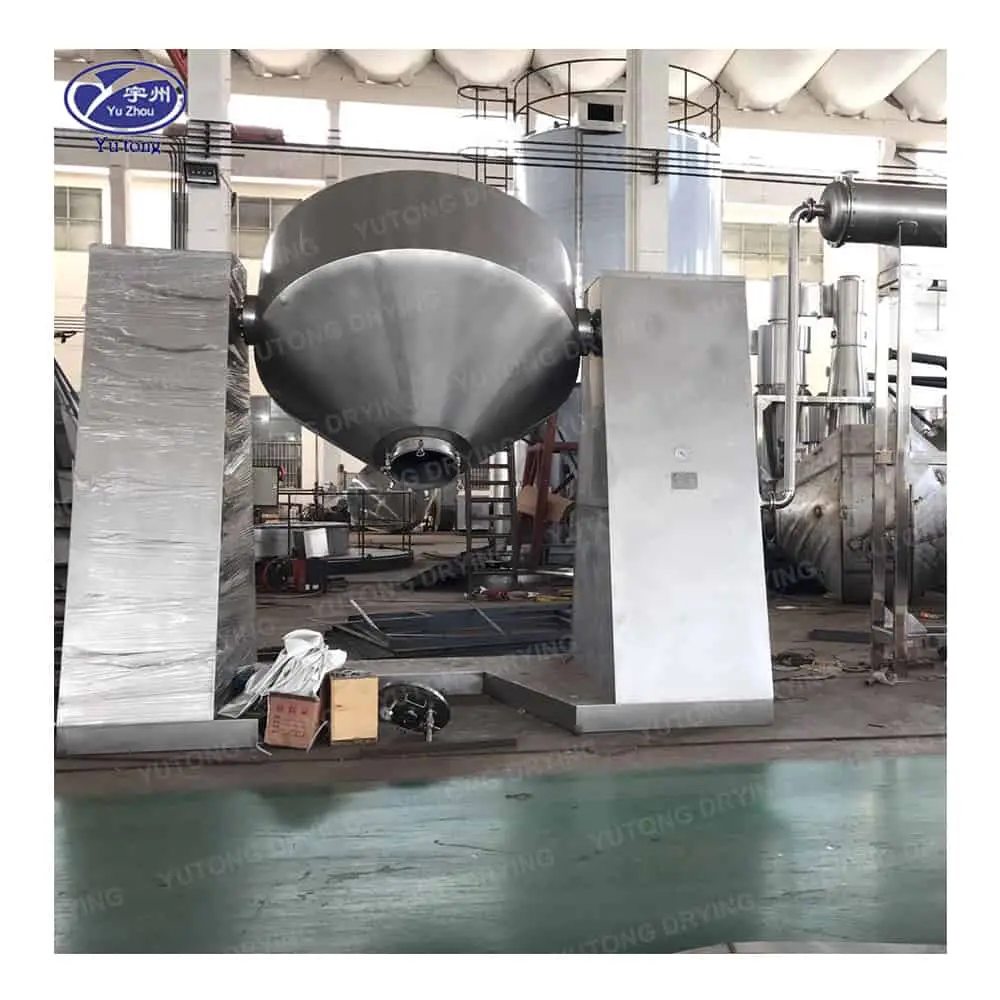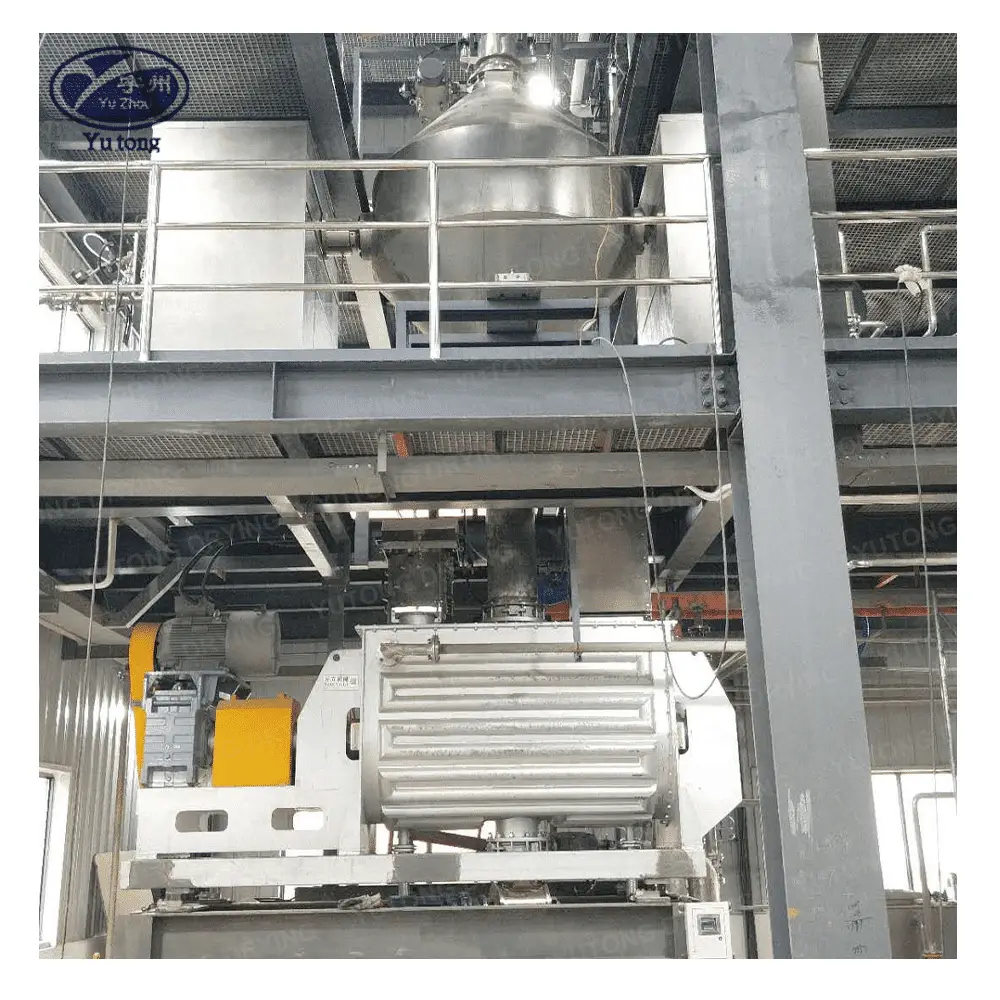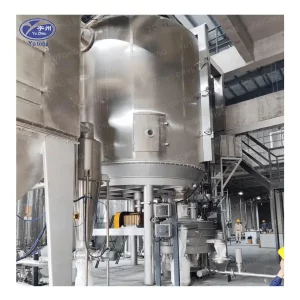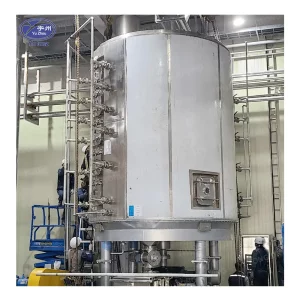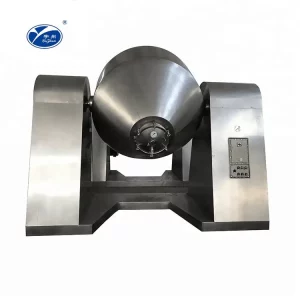Table of Contents
Product Detail
In the realm of industrial drying solutions, the vacuum double drum dryer emerges as a pivotal technology. This sophisticated machinery is essential in transforming liquid or slurry products into dry flakes or powders, offering a host of applications across various industries. Whether you’re dealing with food products like potato flakes or pharmaceutical compounds, understanding the intricacies of a vacuum double drum dryer is crucial for optimizing your drying processes. This piece will delve deeper into the functions, benefits, applications, and considerations of vacuum double drum dryers, providing a comprehensive overview for industry professionals.
What is a Vacuum Double Drum Dryer?
A vacuum double drum dryer is a type of industrial dryer that employs a vacuum to lower the boiling point of liquids. This allows for drying at lower temperatures, preserving the quality of heat-sensitive materials. This technology is particularly effective for drying viscous and sticky substances, which might be challenging to process using conventional drying methods.
Core Components and Structure
The vacuum double drum dryer is composed of several key components that work in unison to achieve efficient drying. The primary components include the two rotating drums, the vacuum system, and the steam heating system. Each of these elements plays a critical role in the drying process. The drums are typically made from stainless steel to withstand high temperatures and corrosive materials. The vacuum system is crucial for creating a low-pressure environment, while the steam heating ensures the necessary heat is applied uniformly.
Operational Mechanism
The operational mechanism of the vacuum double drum dryer involves a delicate balance of heat and pressure. The material to be dried is introduced into the system where it is evenly distributed between the two drums. As these drums rotate, the material adheres to their surfaces, forming a thin film. This film is critical as it maximizes surface area exposure, enhancing drying efficiency. The vacuum reduces the pressure, allowing the liquid to evaporate at lower temperatures, which is ideal for heat-sensitive materials.
Material Handling and Processing
Handling and processing materials with a vacuum double-drum dryer requires precision and control. The consistency and viscosity of the material being dried can significantly affect the drying process. Understanding the properties of the material, such as its boiling point and thermal sensitivity, is essential for setting the appropriate operational parameters. This ensures that the drying process is both efficient and effective, resulting in a high-quality dried product.
Advantages of Using a Vacuum Double Drum Dryer
Efficiency and Speed
One of the standout benefits of vacuum double drum dryers is their efficiency. By operating under reduced pressure, these dryers can remove moisture quickly without the need for high temperatures. This not only speeds up the drying process but also reduces energy consumption, leading to cost savings. Additionally, the quick drying time minimizes the risk of material degradation, making it a preferred choice for industries where time is a critical factor.
Preservation of Quality
Maintaining quality during drying is paramount for products that are sensitive to heat, such as certain pharmaceuticals and food items. The vacuum environment allows drying at low temperatures, preserving the nutritional and sensory qualities of the product. This is particularly beneficial when dealing with products like potato flakes, where flavor and texture retention are critical. The gentle drying process ensures that volatile compounds and essential nutrients are retained, enhancing the product’s quality and market value.
Versatility and Adaptability
Vacuum double drum dryers are versatile machines capable of handling a wide range of products. From sticky and viscous slurries to heat-sensitive liquids, these dryers can accommodate various consistencies, making them ideal for diverse industrial applications. Their adaptability extends to the ability to process different batch sizes and formulations, providing flexibility for manufacturers. This versatility is particularly advantageous in industries that require frequent product changeovers or have diverse product lines.
Energy Efficiency and Sustainability
The energy efficiency of vacuum double drum dryers contributes to their sustainability. By utilizing lower temperatures and reducing drying times, these dryers consume less energy compared to conventional drying methods. This not only lowers operational costs but also reduces the environmental impact, aligning with the growing demand for sustainable industrial practices. Innovations in design and materials continue to enhance the energy efficiency of these dryers, making them a forward-thinking choice for environmentally conscious businesses.
Applications of Vacuum Double Drum Dryers
Food Industry
In the food industry, vacuum double drum dryers are commonly used for producing potato flakes, a key ingredient in many instant foods. The gentle drying process ensures that the nutritional content and taste of the potatoes are preserved, resulting in a high-quality end product. Beyond potatoes, these dryers are also employed for drying fruits, vegetables, and other food products that require careful handling to maintain their nutritional integrity and sensory qualities.
Pharmaceutical Industry
In pharmaceuticals, vacuum double drum dryers are employed to dry heat-sensitive compounds without degrading their active ingredients. This ensures the medication’s efficacy remains intact while achieving the desired moisture content. The precision and control offered by these dryers are essential for meeting stringent industry standards and ensuring patient safety. They are handy for drying antibiotics, enzymes, and other bioactive compounds that are sensitive to heat and moisture.
Chemical Industry
The chemical industry benefits from the precise drying capabilities of vacuum double drum dryers, especially when dealing with reactive or temperature-sensitive chemicals. The controlled environment ensures safe and consistent drying outcomes. These dryers are used for drying polymers, resins, and other chemical compounds where maintaining structural integrity and chemical properties is crucial. The ability to handle hazardous and volatile substances safely is a significant advantage in this sector.
Agricultural and Biotechnology Sectors
In the agricultural sector, vacuum double drum dryers are used to process farming by-products and enhance their value. They are also utilized in biotechnology for drying cultures and other biological materials where preserving bioactivity is essential. The ability to dry materials gently and effectively is critical in these sectors, where product quality and efficacy are of the utmost importance.
Key Considerations When Choosing a Vacuum Double Drum Dryer
Material Compatibility
Before selecting a vacuum double drum dryer, it’s vital to ensure that the materials you’re working with are compatible with this type of drying process. Consider the physical properties of your product, such as viscosity and sensitivity to heat, to determine if this dryer is the right fit. Compatibility assessments should also include an evaluation of the material’s chemical properties and any potential reactions that may occur during the drying process.
Capacity and Size
The dryer’s capacity should align with your production needs. Assess the volume of material you need to process regularly and choose a dryer that can handle this workload efficiently. Additionally, consider the space available in your facility, as these machines can be sizable. It’s important to balance capacity with operational efficiency to ensure that the dryer meets your production demands without compromising on performance or quality.
Maintenance and Operational Costs
Like any industrial equipment, vacuum double drum dryers require regular maintenance to operate optimally. Evaluate the maintenance needs and operational costs to ensure they fit within your budget. Opt for models with user-friendly designs that simplify cleaning and upkeep. Consider the availability of spare parts and technical support, as these factors can significantly impact the long-term operational costs and reliability of the equipment.
Technological Features and Innovations
When choosing a vacuum double drum dryer, consider the technological features and innovations that can enhance performance and efficiency. Modern dryers may come equipped with advanced controls, automation, and monitoring systems that provide real-time data and analytics. These features can improve process control, reduce energy consumption, and enhance product quality, offering a competitive edge in today’s fast-paced industrial landscape.
Innovations in Vacuum Double Drum Drying Technology
The field of vacuum double drum drying is continuously evolving, with innovations aimed at enhancing efficiency and sustainability. Modern dryers are now equipped with advanced controls and automation, allowing for precise monitoring and adjustments during the drying process. This not only improves the quality of the dried product but also reduces energy consumption and operational costs. Innovations in materials and design are also contributing to the durability and performance of these dryers, extending their lifespan and reducing maintenance requirements.
Automation and Control Systems
Automation and control systems have revolutionized the operation of vacuum double drum dryers. These systems allow operators to monitor and adjust drying parameters in real time, ensuring optimal conditions throughout the drying process. The integration of sensors and data analytics enhances process control, allowing for predictive maintenance and reducing downtime. Automation also improves safety by minimizing human intervention and exposure to hazardous materials.
Energy-Efficient Designs
Innovations in energy-efficient designs are making vacuum double drum dryers more sustainable. Improved insulation, advanced heat exchangers, and optimized drum configurations reduce energy consumption and improve thermal efficiency. These advancements contribute to lower operational costs and a reduced carbon footprint, aligning with global efforts to promote sustainable industrial practices. The development of hybrid systems that combine multiple drying technologies is also enhancing efficiency and versatility.
Material and Structural Advancements
Advancements in materials and structural design are enhancing the performance and durability of vacuum double drum dryers. The use of high-strength alloys and corrosion-resistant materials extends the equipment’s lifespan and reduces maintenance needs. Innovative structural designs improve heat transfer and material flow, increasing drying efficiency and product quality. These advancements ensure that vacuum double drum dryers remain at the forefront of drying technology.
Conclusion
The vacuum double drum dryer is an indispensable tool in various industries, thanks to its ability to efficiently dry heat-sensitive and viscous materials while preserving their quality. By understanding the operation, advantages, and applications of this technology, businesses can make informed decisions and optimize their drying processes. Whether in the food, pharmaceutical, or chemical sectors, the vacuum double drum dryer offers a reliable solution for achieving high-quality dried products.
Incorporating a vacuum double drum dryer into your production line can significantly enhance your operational efficiency and product quality, making it a worthy investment for industries aiming to stay competitive in today’s market. As technology continues to advance, staying informed about the latest innovations and best practices in vacuum double drum drying will ensure that your processes remain at the forefront of efficiency and innovation, allowing your business to thrive in an ever-evolving industrial landscape.
Specifications
|
Model
|
100
|
500
|
1000
|
1500
|
2000
|
5000
|
|
Volume (L)
|
100
|
500
|
1000
|
15000
|
2000
|
5000
|
|
Maximum Loading Volume (L)
|
40
|
200
|
400
|
600
|
800
|
2000
|
|
Maximum Loading Capacity (kg)
|
20
|
100
|
200
|
300
|
400
|
1000
|
|
Rotating Speed (rpm)
|
3~13
|
6
|
5
|
4
|
||
|
Motor Power (k w)
|
0.75
|
1.5
|
3
|
4
|
5.5
|
15
|
|
Floor Area (mm)
|
2160 × 800
|
2350× 800
|
2860 × 1300
|
3060 × 1300
|
3260 × 1400
|
4400 × 2500
|
|
Rotation Height (mm)
|
1750
|
2250
|
2800
|
2940
|
2990
|
4200
|
|
Design Pressure In Container (MPa)
|
-0.09 to 0.096
|
|||||
|
Interlayer Design Pressure (MPa)
|
≤ 0.3
|
|||||
|
Weight (kg)
|
800
|
1200
|
2800
|
3300
|
3600
|
8600
|
Applications
Applicable Industries: Machinery Repair Shops, Food & Beverage Factory, Farms, Retail, Food Shop, Energy & Mining, Food & Beverage Shops

